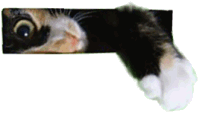Cats as pest controllers - the lessons from Macquarie Island
Cats, and particularly feral cats, have come in for a lot of criticism in recent years. They are depicted as monsters which have devastating effects on the environment and in particular on bird populations. It is undeniable that cats will prey on birds when other, more stable food sources (e.g. rodents) are in short supply. However cats also play a part in the local ecology and their drastic eradication may cause the very disasters which they are sometimes accused of creating. As an example of how difficult such issues are to foresee, we have the case of Macquarie Island. |
Macquarie Island is a small island (35 km wide and 5 km long) in the southern Pacific Ocean, lying about half way between New Zealand and Antarctica. Since 1997 the island has been a world heritage site. At the turn of 19th century, ships carrying the island's the first European visitors inadvertently introduced rats and mice to the Island. With no natural predators to keep their numbers in check, the quickly expanding rodent population became a menace. To protect their food supplies, human settlers brought in cats.
A few decades later some well-meaning individual left rabbits to breed on the Island. These were meant to be food for the settlers. Though the cats quickly added the rabbits to their menu no amount of human or feline predation could keep the rabbit population in check. Rabbits in their thousands began devastating the island's unique flora. Something had to be done quickly to bring the rabbit population under control, so in 1968 a European rabbit flea which carried the myxoma virus was introduced. Myxoma virus causes moxomatosis in European rabbits - a severe disease which kills most rabbits within two weeks of infection. The rabbit population of Macquarie was decimated from about 130,000 to 10,000 and the island's vegetation began showing visible signs of recovery.
However, the myxoma virus did not kill all the rabbits and the survivirs developed natural resistance to the virus. However, the drastic drop in rabbit numbers meant a drastic drop in the food available for the feral cats which had hunted the rabbits. These now turned to hunting the native seabird population. The Australian government, which has charge of these matters on Macquarie Island decided that the only way to protect the seabrids was to get rid of the cats. So from 1985 cats were selectively hunted, until and in June 2000 the last of nearly 2500 cats was eliminated. The seabird population recovered but without the cats, so did the rabbit and the rodent populations. Without predation by cats and now resistant to the Myxoma virus, the rabbit population on the Island soared to an estimated 100,000 rabbits in 2008. Rabbits and rats were once again an ecological disaster.
According to a recent report: 'Since 2000, rabbit herbivory has caused substantial damage at both local and landscape scales including changes from complex vegetation communities, to short, grazed lawns or bare ground.' The native birds are also not protected since rats and mice - whose numbers increased dramatically following the elimination of cats - feed on bird eggs and threaten the chicks. So, it appears that after all those efforts, we are worse off than when we started ('we' - being used here broadly to mean human intervention). The only thing which humans have managed to achieve successfully is to eliminate the only predator which was keeping the population of rabbits and rodents in check.
The Macquarie Island story is not that dissimilar to what happened in Medieval Europe during the Black Death where the cause and effect are very similar. Cats were linked with witchcraft and they and the humans they lived with faced persecution and death. Cats were killed in large numbers, and plague-bearing rats took advantage of their absence to multiply and spread to a threatening extent. Certainly Macquarie Island would have been better off if rodents, rabbits and cats had not been introduced in the first place. But they were and trying to sort out the problem by eradicating cats was a devastating failure. This should be a wake-up call to those advocating the complete eradication of feral cat populations in our cities. Although the number of feral cats should be controlled, the complete eradication of an area's population of unpaid pest controllers may create problems the eradicators have not planned or have solutions for.
This video is a light-hearted representation of cat's predatory instincts toward rabbits.
Journal reference:
Dana M. Bergstrom, Arko Lucieer, Kate Kiefer Jane Wasley, Lee Belbin, Tore K. Pedersen and Steven L. Chown. Indirect effects of invasive species removal devastate World Heritage Island. Journal of Applied Ecology, 2009; 46, pp 73-81


